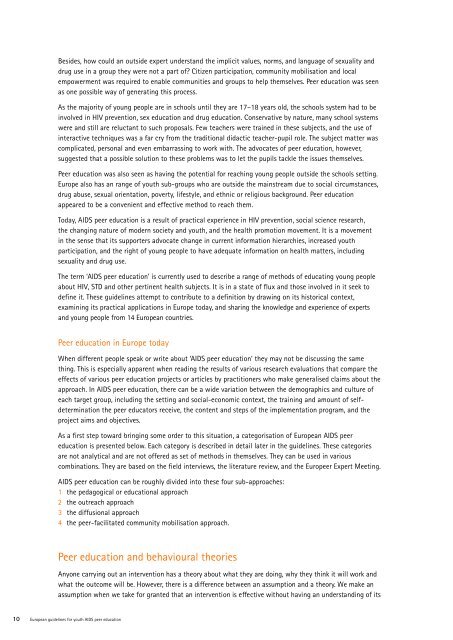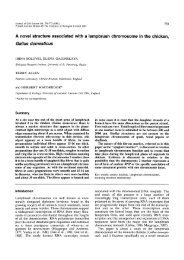European guidelines for youth AIDS peer education - University of ...
European guidelines for youth AIDS peer education - University of ...
European guidelines for youth AIDS peer education - University of ...
- No tags were found...
Create successful ePaper yourself
Turn your PDF publications into a flip-book with our unique Google optimized e-Paper software.
Besides, how could an outside expert understand the implicit values, norms, and language <strong>of</strong> sexuality anddrug use in a group they were not a part <strong>of</strong>? Citizen participation, community mobilisation and localempowerment was required to enable communities and groups to help themselves. Peer <strong>education</strong> was seenas one possible way <strong>of</strong> generating this process.As the majority <strong>of</strong> young people are in schools until they are 17–18 years old, the schools system had to beinvolved in HIV prevention, sex <strong>education</strong> and drug <strong>education</strong>. Conservative by nature, many school systemswere and still are reluctant to such proposals. Few teachers were trained in these subjects, and the use <strong>of</strong>interactive techniques was a far cry from the traditional didactic teacher-pupil role. The subject matter wascomplicated, personal and even embarrassing to work with. The advocates <strong>of</strong> <strong>peer</strong> <strong>education</strong>, however,suggested that a possible solution to these problems was to let the pupils tackle the issues themselves.Peer <strong>education</strong> was also seen as having the potential <strong>for</strong> reaching young people outside the schools setting.Europe also has an range <strong>of</strong> <strong>youth</strong> sub-groups who are outside the mainstream due to social circumstances,drug abuse, sexual orientation, poverty, lifestyle, and ethnic or religious background. Peer <strong>education</strong>appeared to be a convenient and effective method to reach them.Today, <strong>AIDS</strong> <strong>peer</strong> <strong>education</strong> is a result <strong>of</strong> practical experience in HIV prevention, social science research,the changing nature <strong>of</strong> modern society and <strong>youth</strong>, and the health promotion movement. It is a movementin the sense that its supporters advocate change in current in<strong>for</strong>mation hierarchies, increased <strong>youth</strong>participation, and the right <strong>of</strong> young people to have adequate in<strong>for</strong>mation on health matters, includingsexuality and drug use.The term ‘<strong>AIDS</strong> <strong>peer</strong> <strong>education</strong>’ is currently used to describe a range <strong>of</strong> methods <strong>of</strong> educating young peopleabout HIV, STD and other pertinent health subjects. It is in a state <strong>of</strong> flux and those involved in it seek todefine it. These <strong>guidelines</strong> attempt to contribute to a definition by drawing on its historical context,examining its practical applications in Europe today, and sharing the knowledge and experience <strong>of</strong> expertsand young people from 14 <strong>European</strong> countries.Peer <strong>education</strong> in Europe todayWhen different people speak or write about ‘<strong>AIDS</strong> <strong>peer</strong> <strong>education</strong>’ they may not be discussing the samething. This is especially apparent when reading the results <strong>of</strong> various research evaluations that compare theeffects <strong>of</strong> various <strong>peer</strong> <strong>education</strong> projects or articles by practitioners who make generalised claims about theapproach. In <strong>AIDS</strong> <strong>peer</strong> <strong>education</strong>, there can be a wide variation between the demographics and culture <strong>of</strong>each target group, including the setting and social-economic context, the training and amount <strong>of</strong> selfdeterminationthe <strong>peer</strong> educators receive, the content and steps <strong>of</strong> the implementation program, and theproject aims and objectives.As a first step toward bringing some order to this situation, a categorisation <strong>of</strong> <strong>European</strong> <strong>AIDS</strong> <strong>peer</strong><strong>education</strong> is presented below. Each category is described in detail later in the <strong>guidelines</strong>. These categoriesare not analytical and are not <strong>of</strong>fered as set <strong>of</strong> methods in themselves. They can be used in variouscombinations. They are based on the field interviews, the literature review, and the Euro<strong>peer</strong> Expert Meeting.<strong>AIDS</strong> <strong>peer</strong> <strong>education</strong> can be roughly divided into these four sub-approaches:1 the pedagogical or <strong>education</strong>al approach2 the outreach approach3 the diffusional approach4 the <strong>peer</strong>-facilitated community mobilisation approach.Peer <strong>education</strong> and behavioural theoriesAnyone carrying out an intervention has a theory about what they are doing, why they think it will work andwhat the outcome will be. However, there is a difference between an assumption and a theory. We make anassumption when we take <strong>for</strong> granted that an intervention is effective without having an understanding <strong>of</strong> its10 <strong>European</strong> <strong>guidelines</strong> <strong>for</strong> <strong>youth</strong> <strong>AIDS</strong> <strong>peer</strong> <strong>education</strong>
















